#nepalese
Photo
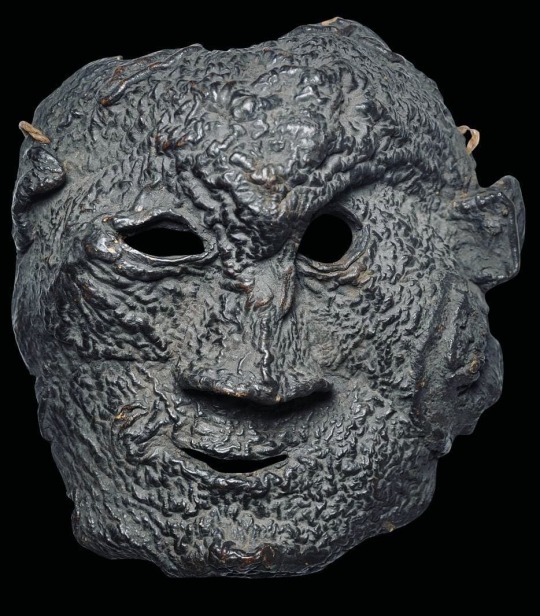
Nepalese Lingzhi Fungus Mask, probably 19th century
This extraordinary mask has been formed from a large, single Lingzhi fungus (Ganoderma Lucidum). The natural structure of the fungus has been coaxed into forming a nose, ears, a mouth and eyes. Two holes on either side allow for a natural twine to have been threaded through so that the mask can be either worn or hung for (perhaps) ritual display. The surface is hard, glossy and dramatically wrinkled.
It is believed that such masks were worn ritually to frighten off malevolent spirits. Most extant fungus masks are of black (or blackened) Lingzhi fungus. Pannier (2009, p. 68) illustrates a mask translated as a ‘mushroom’ mask which appears to be made from a single fungus – possibly a Lingzhi – but coloured with red pigment.
Nepalese fungus masks are rare. Dating them is difficult. There are few in private or museum collections. The surface is glossy and encrusted with a varying patina suggesting some significant age. Possibly it was darkened with soot although there is no residual smokiness present.
The example here is in an excellent, stable condition with just the odd small loss to the extremities as might be expected. The texture is hard and robust rather than crumbly and friable. It has a wood-like consistency.
915 notes
·
View notes
Text
Jane is a nurse and business developer. She advocacates for body positivity and women's hormonal and mental health.


#jane Garrett#Nepalese#Nepal#miss universe#plus size#pageant#curve model#body positivity#fat positive
122 notes
·
View notes
Text

Killing for the sole purpose of killing: Hamas mass-executes Nepalese and Thai nationals on 7/10.
On the 7th of October massacres, nationals from dozens of countries were killed, injured, and kidnapped by Hamas. Many of them were Thai and Nepalese nationals who were part of agricultural education programs in southern Israel, sent to learn Israeli methods to take back to their homelands.
In this coming footage we will show how Hamas terrorists rounded up Nepalese and Thail nationals at Kibbutz Alumim, threw them into a killing room, and slaughtered them in an act of cold-blooded murder.
59 notes
·
View notes
Text

Chicken Sadeko
#food#recipe#dinner#sadeko#chicken sadeko#chicken salad#chicken#rice#onions#tomatoes#peppers#cilantro#lemon#cumin#gluten free#dairy free#nepalese
60 notes
·
View notes
Text


Nimdoma Sherpa
#nimdoma sherpa#nature#naturecore#women of color#woc#nepal#nepalese#south asian#tropical#jungle#junglecore
125 notes
·
View notes
Text

Kukri from the Kingdom of Nepal dated to the Mid 19th Century on display at the Gurkha Museum in Winchester, England
This kukri belonged to Maharajah Sir Jung Bahadur Rana who wore it at the Siege of Lucknow when commanding the Nepalese Contingent in 1857. The Nepalese forces assisted the British Empire in putting down the Indian rebellion against the colonial forces occupying much of India. Jung Bahadur is a controversial figure as he is seen to have set up an oppressive dictatorship called the Rana Dynasty that lasted for over a hundred years. Others blame his nephews, the Shumsher Ranas for this.
Photographs taken by myself 2023
#military history#nepal#nepalese#19th century#rana dynasty#art#kingdom of nepal#gurkha museum#winchester#barbucomedie
8 notes
·
View notes
Text

Nose Ring, 1700s–1800s. Nepal
#nepal#nepalese#southeast asia#southeastasia#jewelry#jewellery#nose piercing#nose ring#gemstone#beaded jewelry#beadwork#1700s#18th century
8 notes
·
View notes
Photo

Anjali Lama
Gender: Transgender woman
Sexuality: N/A
DOB: Born 1985
Ethnicity: Nepalese
Occupation: Model, activist
#Anjali Lama#lgbt#lgbtq#trans femme#qwoc#transgender#trans woman#1985#poc#nepalese#asian#model#activist
55 notes
·
View notes
Text
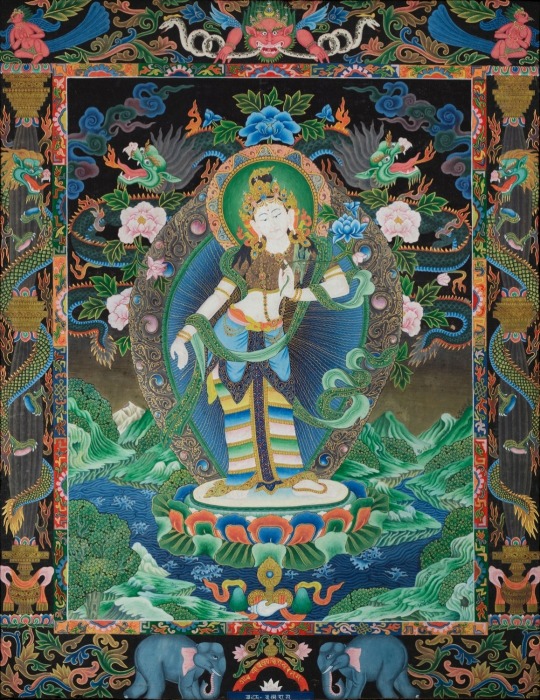

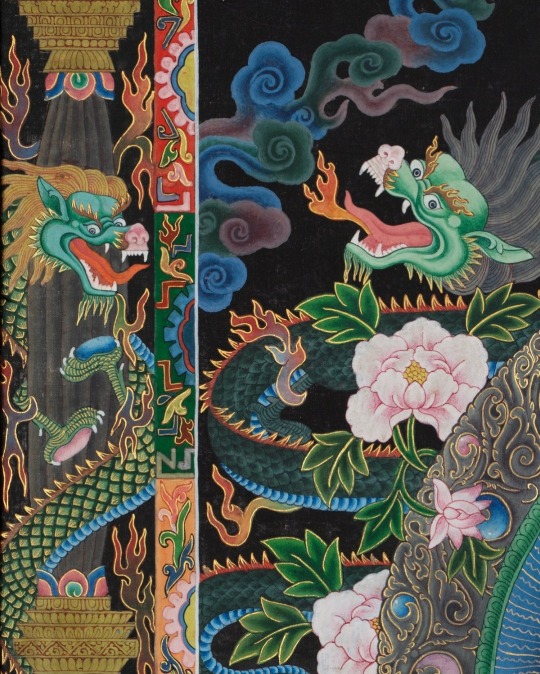


Newari Style Bodhisattva Padmapani Lokeshvara in 24 carat gold, gouache and acrylic colors on cotton canvas.
#no artist identification#buddhist art#newari#nepalese#thangka#buddhism#padmapani lokeshvara#bodhisattva
35 notes
·
View notes
Text

WILD MAN IN A WILD WORLD -- EARTH YETI.
PIC INFO: Spotlight on the Yeti of Nepalese folklore, watercolors by the late, great Eric Carle (1929-2021), from the children's book "Dragons Dragons and Other Creatures that Never Were" (1988).
"The Yeti is a manlike beast,
Unless, perchance, he doesn't exist.
He walks like a man and has hair on his face,
And rumors persist
That in forests and caves where no one goes,
Or high in the Himalayan snows,
He may still be living. Nobody knows.
If you meet him and ask him,
"Are you a Yeti?"
All he can say is, "Maybe.""
-- JOHN GARDNER (1933-1982)
Source: www.fairyroom.ru/?p=56315.
#Yeti#Nepalese folklore#Illustration#Abominable Snowman#Cryptozoology#Nepalese#Watercolors#Children's books#Kids books#1988#1980s#Eric Carle#Cryptids#Cryptid#Nepalese Mythology#Mythology#Eastern folklore#Folklore#Himalyas#Mythical Creatures#Mythical#Poetry#The Himalayas#Nepal#Poems#Mythological Beasts#Eastern Mythology#Eric Carle Art#Dragons Dragons#Dragons Dragons and Other Creatures that Never Were
3 notes
·
View notes
Photo
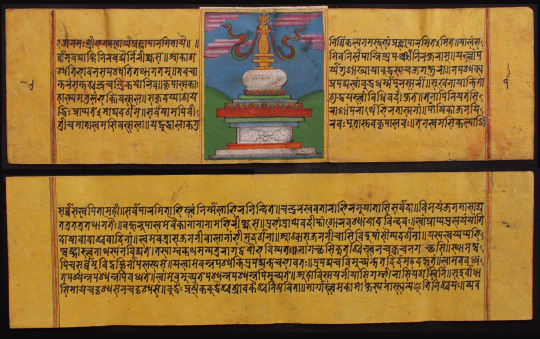
The majority of Buddhist Sanskrit texts were preserved by the Newar people of the Kathmandu valley in Nepal, and so the most common scripts in which Buddhist Sanskrit texts are written are those used by the Newars, predominantly in the Prachalit script, like this manuscript.
The rest of Buddhist Sanskrit texts were preserved in Tibet and East Asia, where they were written in the Tibetan and Siddham scripts. Ranjana and Lantsa were also used for some texts, but they’re mostly decorative. Before Prachalit other scripts were also used, like Bhujimol, but less manuscript remain in this script because it’s older and ceased to be the dominant script for writing Sanskrit sometimes in the 15-16th century when Prachalit took over.
In contrast, the majority of Hindu and Jain Sanskrit texts were preserved in scripts used in India, like Devanagari, Nandinagari, and Grantha.
#buddhist#buddhism#sanskrit#newar#newari#newa#prachalit#pracalit#nepal#nepalese#ranjana#lantsa#tibetan#siddham#manuscripts#calligraphy
11 notes
·
View notes
Text
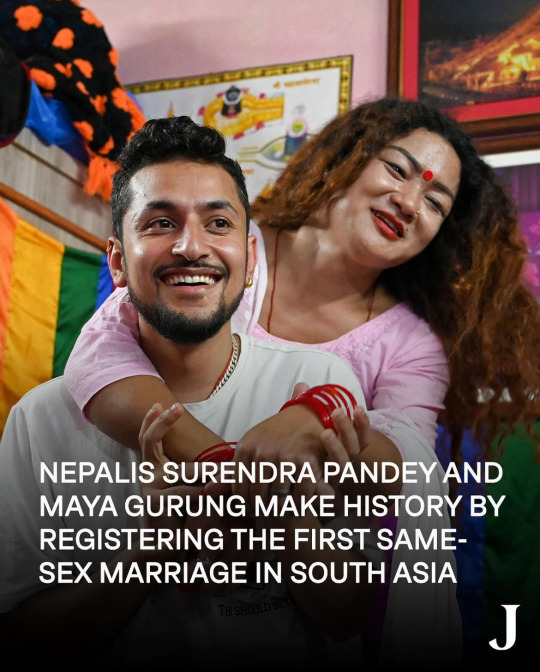
From The Juggernaut: 🏳️🌈On November 29, #Nepal became the first #SouthAsian country to register a same-sex marriage.
“Finally, we are completely together. Finally, we are completely each other’s,” Maya Gurung, 37, told The Guardian.
“We did it. We can have a beautiful future now,” Surendra Pandey, 27, told The Guardian.
In 2007, Nepal’s courts directed the government to amend laws to allow same-sex marriages, but legislators failed to bring any such amendments to Parliament. In June, Nepal’s Supreme Court issued an interim order that recognized the registry of same-sex marriages since legislators had failed to amend marriage laws.

Gurung and Pandey were married in a Hindu wedding in 2017. Gurung was born a man and identifies as a trans woman; Pandey was born a man and identifies as a man. But Nepal prohibits citizens from changing the sex assigned at birth on official documents, so the couple couldn’t open a joint bank account, buy property together, or adopt a child together.
After the Supreme Court’s interim order, the couple tried to register at the Kathmandu District Court and High Court. But they still faced pushback — until Gurung's hometown, Dordi municipality, a few miles west of #Kathmandu, stepped in and agreed to register the couple.
Nepal is the second country in Asia, after Taiwan, to recognize same-sex marriage. India’s Supreme Court refused to legalize same-sex marriage earlier this year.
“We will continue our campaign for same-sex marriage and fight to bring equality to sexual minorities in the country, so that generations of people will not have to suffer like we all did,” Gurung told reporters Friday, AP reported.
Sunil Babu Pant, a former legislator and LGBTQ+ rights activist, told AP: “It is just not same-sex marriage, but it is very inclusive…man can marry man, woman can marry woman. As we have three genders — male, female and others — others can marry others also and others can marry man [or woman].”
Read more about how India is still fighting for LGBTQ rights at the link in bio, then click this image 🔗
#same sex marriage#marriage equality#South Asia#nepal#Nepalese#lgbtqia#lgbt#queer#marriage#discrimination#queer rights#trans#India#the juggernaut#desi#qpoc#south asian
10 notes
·
View notes
Text

Armored Cavalryman.
Tibetan, and possibly Bhutanese and Nepalese
18th–19th century.
This figure has been assembled based on photographs taken in the 1930s and 1940s in the Tibetan capital of Lhasa during the Great Prayer Festival. The photographs showed troops of ceremonial armored cavalry, who wore a standardized set of equipment as stipulated by the central government of Tibet probably from the mid-seventeenth or eighteenth century onward. The equipment included a helmet, a mail shirt, a set of four mirrors, an armored belt, a bow case and quiver, a matchlock musket, a bandoleer with gunpowder and bullets, and a short spear for the rider, as well as a saddle, saddle rug, and tack for the horse. Armed and equipped in a similar fashion, Tibetan government officials were periodically required to demonstrate proficiency on horseback with musket, bow and arrow, and spear until as late as the mid twentieth century.
@metarmsandarmor
3 notes
·
View notes
Text

Kathmandu, Nepal.
Ashraful Arefin
#ashraful arefin#kathmandu#nepal#nepalese#south asia#south asian#desi tumblr#desi tag#ph#portrait photography#peoplehood
30 notes
·
View notes
Text
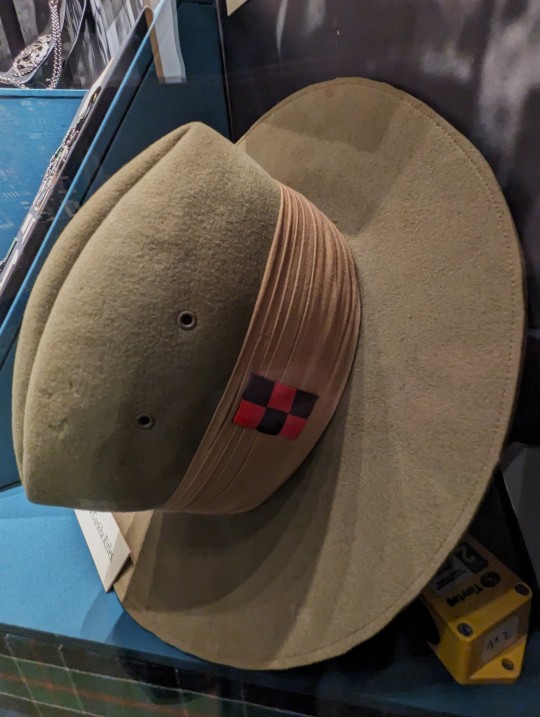
Felt "Terai" Hat of the 2nd King Edward VII's Own Gurkha Rifles (The Sirmoor Rifles) from the British Empire dated to the 1940s on display at the Gurkha Museum in Winchester, England
Felt "Terai" hats like this were popular amongst the Gurkha regiments in the British Empire during the mid 20th century. They offered protection from the sun and would have been practical for the places the 2nd Gurkha Rifles were fighting during the Second World War. They fought the fascists in Cyprus, the North African campaign, the invasion of Italy and many took part in the Chindit operations in Burma as well against the Empire of Japan.
Photographs taken by myself 2023
#uniform#military history#second world war#british empire#nepalese#nepal#gurkhas#20th century#fashion#gurkha museum#winchester#barbucomedie
4 notes
·
View notes
